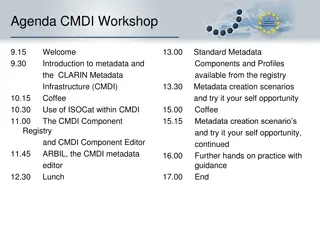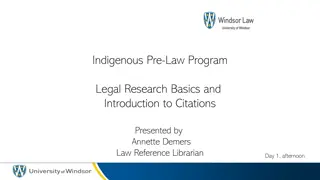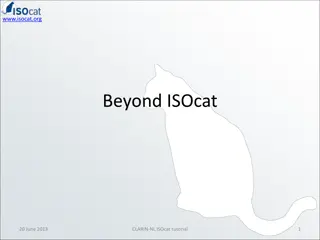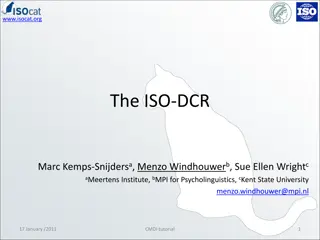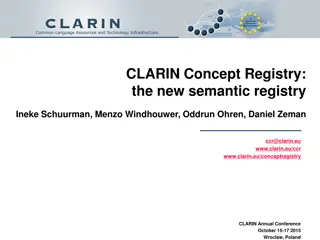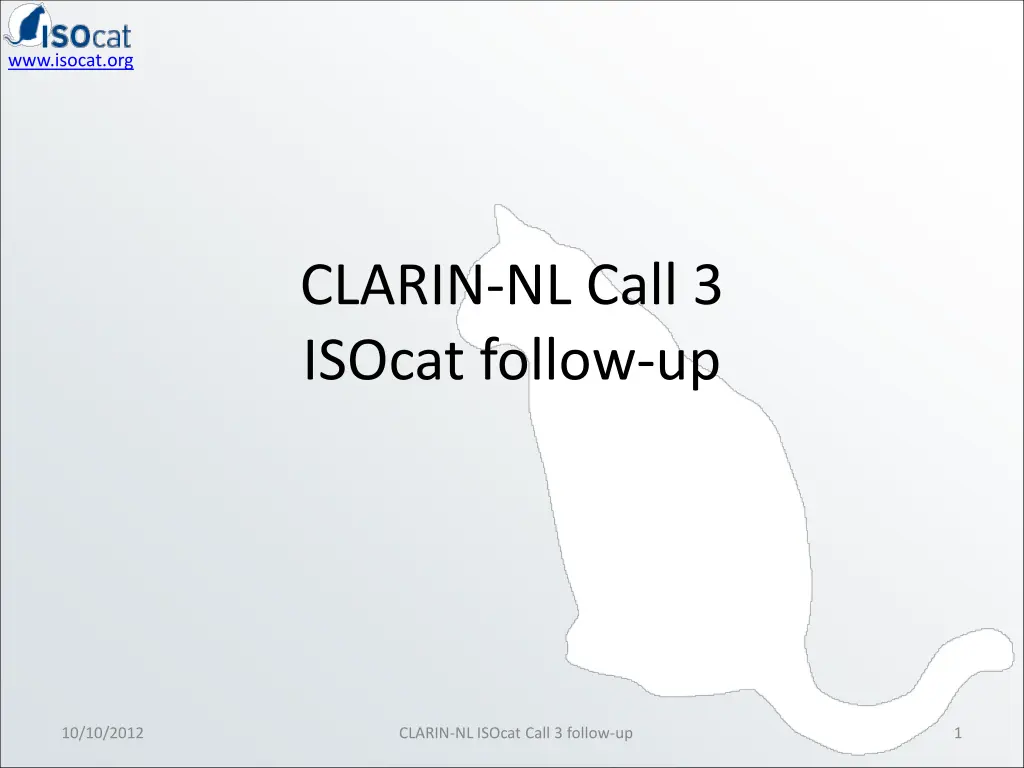
Data Category Structures in www.isocat.org
Explore the intricate structures of data categories in www.isocat.org, understanding complex, simple, container, and closed categories. Learn how to categorize and constrain data types effectively in your resources.
Download Presentation

Please find below an Image/Link to download the presentation.
The content on the website is provided AS IS for your information and personal use only. It may not be sold, licensed, or shared on other websites without obtaining consent from the author. If you encounter any issues during the download, it is possible that the publisher has removed the file from their server.
You are allowed to download the files provided on this website for personal or commercial use, subject to the condition that they are used lawfully. All files are the property of their respective owners.
The content on the website is provided AS IS for your information and personal use only. It may not be sold, licensed, or shared on other websites without obtaining consent from the author.
E N D
Presentation Transcript
www.isocat.org www.isocat.org CLARIN-NL Call 3 ISOcat follow-up 10/10/2012 CLARIN-NL ISOcat Call 3 follow-up 1
www.isocat.org www.isocat.org Topics Data Category types Bulk import Beyond ISOcat RELcat SCHEMAcat 10/10/2012 CLARIN-NL ISOcat Call 3 follow-up 2
www.isocat.org www.isocat.org Data Category types complex: open constrained closed grammaticalGender writtenForm email string string string Constraint: .+@.+ neuter feminine simple: masculine 10/10/2012 CLARIN-NL ISOcat Call 3 follow-up 3
www.isocat.org www.isocat.org Data Category types container: lexicon language entry alphabet japanese ipa lemma writtenForm 10/10/2012 CLARIN-NL ISOcat Call 3 follow-up 4
www.isocat.org www.isocat.org Which type? Which type is appropriate depends on the place of the data category in the structure of your resource: 1. Can it have a value? Complex Data Category with an data type Any of the values of the data type? Open Data Category Can you enumerate the values? Closed Data Category Fill its value domain with simple Data Categories Is there a rule to constrain the values? Constrained Data Category Express the rule/constraint in one of the rule languages 2. Is it a value? Simple Data Category 3. Does it group other (container or complex) Data Categories? Container Data Categories If a Data Category both has a value and groups Data Categories Complex Data Category 10/10/2012 CLARIN-NL ISOcat Call 3 follow-up 5
www.isocat.org www.isocat.org CMDI example CMD component relates to a container DC CMD element relates to a complex DC CMD value relates to a simple DC The ISOcat search in the CMD Component Editor enforces this Also a DC should be public and member of the Metadata profile However, if you link to a DC nothing of the specification is taken over into your profile 10/10/2012 CLARIN-NL ISOcat Call 3 follow-up 6
www.isocat.org www.isocat.org Some examples S category noun phrase NP VP number singular Text= John agreement V NP person third Text= hit Det N /category/ a closed DC /noun phrase/ a simple DC /agreement/ a container DC /number/ a closed DC /singular/ a simple DC /person/ a closed DC /third/ a simple DC (Encoded as TEI P5 FSR the XML elements and attributes are seen as syntactic sugar) Text= the Text= ball /S/ a container DC /NP/ an open DC /VP/ a container DC /V/ an open DC /NP/ a container DC /Det/ an open DC /N/ an open DC (Text is seen as syntactic sugar) 10/10/2012 CLARIN-NL ISOcat Call 3 follow-up 7
www.isocat.org www.isocat.org GrNe example <morfI>aor. ; . , ep. . 2 plur. en ; ptc. , ep. . ; . en Att. , Ion. plqperf. 3 . ; . . ; </morfI> 1. Better structure: markup the symbols: <morfl> <s>plur.</s> </morfl> 2. Under development: /morfl/ a constrained DC linked to an EBNF grammar in SCHEMAcat (see CGN EBNF) that accepts free text interleaved with a controlled vocabulary 3. Temporary: /morfl/ a closed DC linked to <morfl/> with the controlled vocabulary as its value domain an 10/10/2012 CLARIN-NL ISOcat Call 3 follow-up 8
www.isocat.org www.isocat.org Bulk import: DCIF http://www.isocat.org/forum/viewtopic.php?f=3&t=14 Create a valid DCIF XML document In general by converting an existing digital resource XSLT, Perl, DCIF Schema: http://www.isocat.org/12620/schemas/DCIF.rng Human readable: http://www.isocat.org/12620/schemas/DCIF.html DCIF Validation levels: Structure: Relax NG validation Referential integrity: Schematron validation Example: http://www.isocat.org/12620/examples/dcif- example.dcif 10/10/2012 CLARIN-NL ISOcat Call 3 follow-up 9
www.isocat.org www.isocat.org DCIF Validation Scenario in oXygen 10/10/2012 CLARIN-NL ISOcat Call 3 follow-up 10
www.isocat.org www.isocat.org What will be overwritten? PIDs Just invent your own URI, e.g., my:DC-1 Use them to relate DCs: Closed DC conceptual domain to simple DC Simple DC is-a relation to another simple DC Will be overwritten by ISOcat PIDs Unless you have ISOcat acceptale PIDs Version -> 1:0 Registration status -> private Creation date -> date of import 10/10/2012 CLARIN-NL ISOcat Call 3 follow-up 11
www.isocat.org www.isocat.org Contact ISOcat sysadmin Email: isocat@mpi.nl If you need: Additional languages Additional profiles This will require ISO TC 37 involvement, start with an import in the private profile Additional constraint rule languages If you re done: Send DCIF file Will be validated (again ) Test import cycles on the ISOcat test server Actual import on isocat.org If you want to do bulk updates 10/10/2012 CLARIN-NL ISOcat Call 3 follow-up 12
www.isocat.org www.isocat.org Beyond ISOcat: RELcat http://lux13.mpi.nl/relcat/ Collect typed relationships between your new DCs and existing DCs in an Excel spreadsheet or CSV file with at least three columns 1. Your ISOcat DC PID 2. typed relationship sameAs: same semantics just different types or an uncooperative DC owner almostSameAs: minor, but for you important, differences subClassOf: yours is more specific superClassOf: yours is more general hasPart/partOf: partitive relationships 3. Related ISOcat DC PID (or an URL to an entry in another persistent concept/data category registry) http://www.isocat.org/forum/viewtopic.php?f=12&t=16 10/10/2012 CLARIN-NL ISOcat Call 3 follow-up 13
www.isocat.org www.isocat.org Beyond ISOcat: SCHEMAcat http://lux13.mpi.nl/schemacat/ Annotate your resource schema with ISOcat DC PIDs 1. Use what your schema language provides to link to an external semantic specification ODD: <odd:equiv name= morfl uri= /DC-nnn /> 2. Use @dcr:datcat or @dcr:valueDatcat in an XML-based schema language RNG: <rng:element name= morfl dcr:datcat= /DC-nnn /> 3. Embed an @dcr:datcat annotation in a comment in another (text- based) schema language EBNF: (* @dcr:datcat MORFL /DC-nnn *) 4. Embed an @dcr:datcat annotation in a description or note or MDF: \desc @dcr:datcat /DC-nnn 5. Contact isocat@mpi.nl 10/10/2012 CLARIN-NL ISOcat Call 3 follow-up 14
www.isocat.org www.isocat.org ISOcat user interface Problematic: Simple DC selector for a closed value domain Too slow especially when the closed DC is a member of the Private profile, if more specific, e.g., Metadata, the number of simple DCs loaded will be much smaller Upcoming: replace full list by a search or selection from the basket or viewed DCS Default Private profile Users forget to select the proper profile, making the DC not appear in profile specific searches, e.g., CMDI search for metadata DCs Upcoming: no default profile Distinction between CLARIN-NL/VL candidate DCs and recommended DCs Upcoming: CLARIN-NL/VL recommendations Links between DCs Upcoming: become clickable Later: integration with RELcat for typed relationships 10/10/2012 CLARIN-NL ISOcat Call 3 follow-up 15


